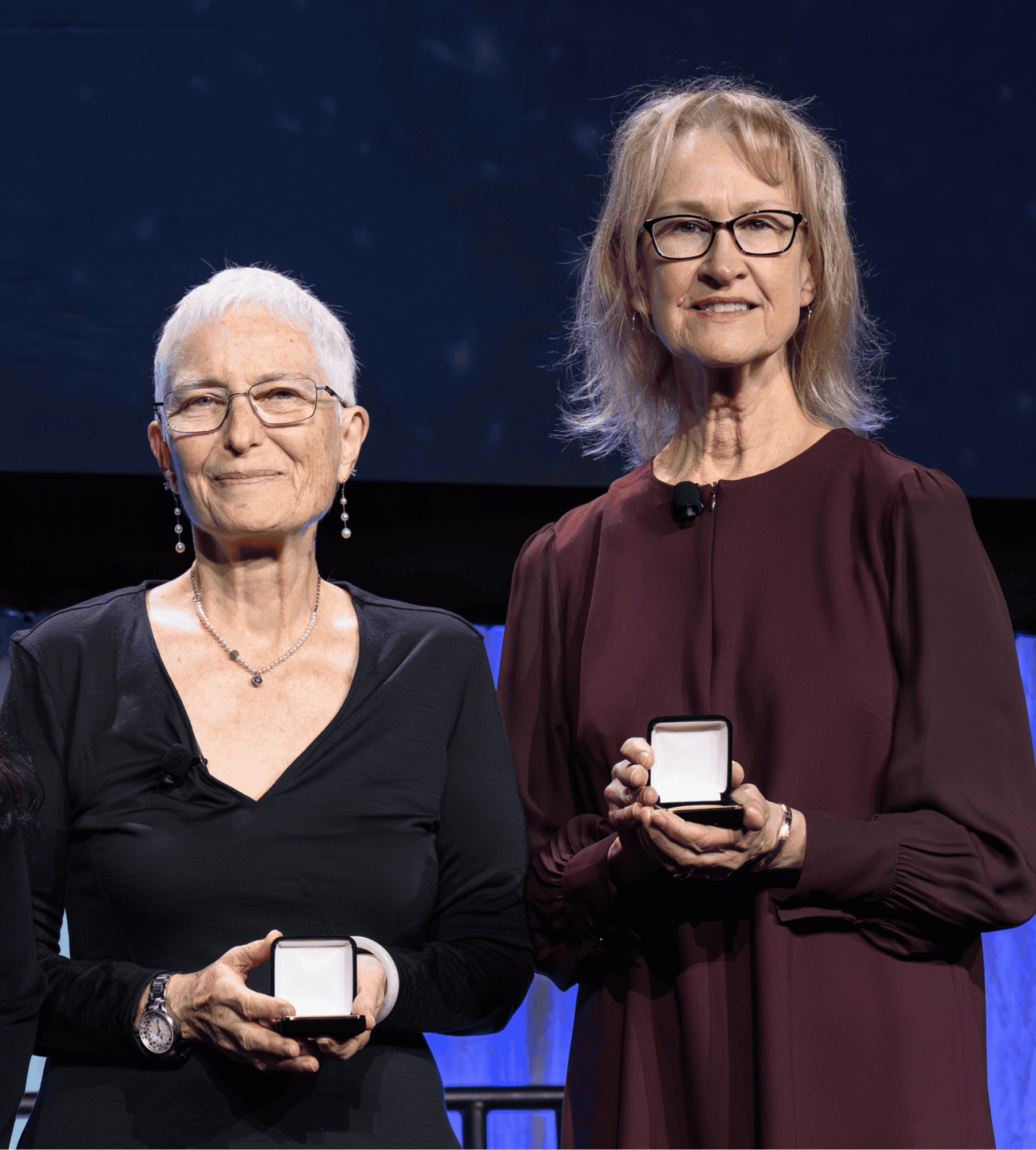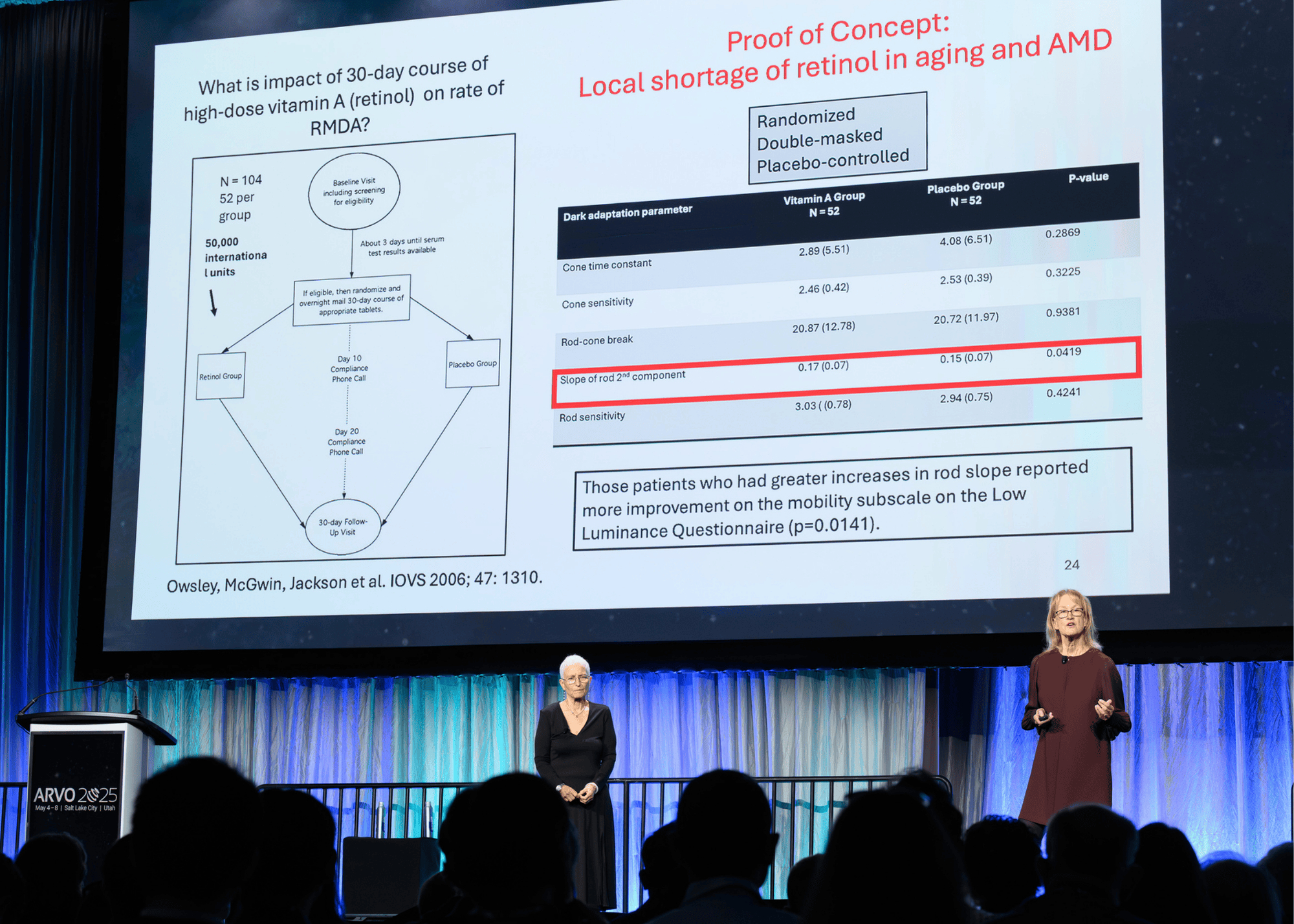 Curcio and Owsley receive the prestigious Proctor Medal during the ARVO annual meeting in Salt Lake City, Utah.
Curcio and Owsley receive the prestigious Proctor Medal during the ARVO annual meeting in Salt Lake City, Utah.
The University of Alabama at Birmingham (UAB) Department of Ophthalmology and Visual Sciences proudly celebrates a historic milestone as Christine A. Curcio, Ph.D., FARVO, and Cynthia Owsley, Ph.D., MSPH, FARVO, were jointly awarded the prestigious 2025 Proctor Medal by the Association for Research in Vision and Ophthalmology (ARVO). The award was presented during ARVO’s annual meeting, held May 4–8, 2025, in Salt Lake City, Utah. On May 5, the longtime collaborators delivered the distinguished Proctor Award Lecture, titled “The Science of Rod-Mediated Dark Adaptation for Age-Related Macular Degeneration.”
This high honor is a testament to Curcio and Owsley’s decades of pioneering work in age-related macular degeneration (AMD) research, which has profoundly influenced how scientists and clinicians understand and pursue early intervention and prevention strategies for this leading cause of central vision loss.
Established in 1949 to honor the legacy of Dr. Francis I. Proctor, the Proctor Medal is one of the highest distinctions in the vision research field. It recognizes exceptional research in the basic or clinical sciences as applied to ophthalmology, and recipients are invited to present the Proctor Award Lecture at ARVO’s annual meeting.
Curcio and Owsley’s lecture brought together over four decades of research on retinal biology, visual function, psychophysics, and aging. Their work, including the groundbreaking ALSTAR and ALSTAR2 studies (ALabama STudy on early Age-Related macular degeneration), explores how rod-mediated dark adaptation declines in early AMD. Their “Center-Surround” model incorporates rod vulnerability and cone resilience at a high-acuity area called the fovea and offers a novel framework for detecting AMD progression before irreversible vision loss occurs.
“Receiving the Proctor Medal is the honor of a lifetime,” said Owsley. “It is incredibly meaningful to have our long-standing collaboration recognized on this international stage, especially for research that is designed to change how we detect and treat AMD in its earliest stages.”
Curcio echoed the sentiment, highlighting the unique interdisciplinary nature of their work. “This recognition affirms the value of connecting human tissue studies with patient-centered outcomes,” said Curcio. “We’ve built a bridge between basic science and clinical relevance, and it’s deeply gratifying to know that our science may help lead to earlier detection and ultimately prevention of vision loss.”
 Curcio and Owsley deliver the distinguished Proctor Award Lecture, titled “The Science of Rod-Mediated Dark Adaptation for Age-Related Macular Degeneration.”Together, Curcio and Owsley have redefined how the field understands aging and early AMD. Curcio, who is a neuroscientist by training and is Professor Emerita, has made seminal contributions to the anatomic and molecular pathobiology of AMD. Her research on the molecular and microscopic composition of extracellular deposits in AMD has shaped imaging diagnostics and has pointed towards new therapeutic approaches. Owsley, Nathan E. Miles Endowed Chair of Ophthalmology, is an experimental psychologist and public health expert who has championed functional assessments that correlate vision loss with underlying retinal structure, especially in older adults navigating real-world challenges such as driving and mobility.
Curcio and Owsley deliver the distinguished Proctor Award Lecture, titled “The Science of Rod-Mediated Dark Adaptation for Age-Related Macular Degeneration.”Together, Curcio and Owsley have redefined how the field understands aging and early AMD. Curcio, who is a neuroscientist by training and is Professor Emerita, has made seminal contributions to the anatomic and molecular pathobiology of AMD. Her research on the molecular and microscopic composition of extracellular deposits in AMD has shaped imaging diagnostics and has pointed towards new therapeutic approaches. Owsley, Nathan E. Miles Endowed Chair of Ophthalmology, is an experimental psychologist and public health expert who has championed functional assessments that correlate vision loss with underlying retinal structure, especially in older adults navigating real-world challenges such as driving and mobility.
Their partnership demonstrates the power of interdisciplinary collaboration and long-term dedication. Both researchers are also committed mentors, having trained generations of scientists, clinicians, and students who are now advancing the field even further.
Brian Samuels, M.D., Ph.D., EyeSight Foundation of Alabama Endowed Chair of the UAB Department of Ophthalmology and Visual Sciences, praised the impact of their careers.
“To have both Dr. Curcio and Dr. Owsley recognized with ARVO’s highest honor is not only a testament to their individual brilliance but to the legacy they’ve built together here at UAB,” said Samuels. “Their work has redefined our understanding of AMD and fundamentally changed the course of vision science. It means so much to all of us that this extraordinary contribution to human health has happened right here in Alabama. We are proud beyond words.”
The nomination package submitted on behalf of Curcio and Owsley by Samuels and Alecia Gross, Ph.D., Professor of Neurobiology, and the UAB Heersink School of Medicine’s Associate Dean of Faculty Affairs and Development, included letters of support from leading ARVO members. Their lecture at ARVO 2025 was met with a standing ovation, underscoring the broad respect and admiration for their contributions.
Looking ahead, both Curcio and Owsley remain committed to the continued advancement of AMD research through the ALSTAR2 study and other collaborative initiatives. Their ongoing work is emblematic of UAB’s mission to improve human health through research, education, and innovation.
Photography thanks to the Association for Research in Vision and Ophthalmology.